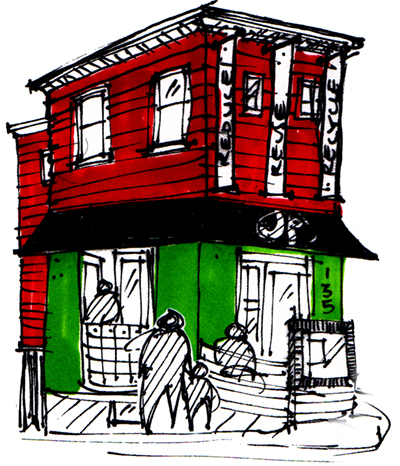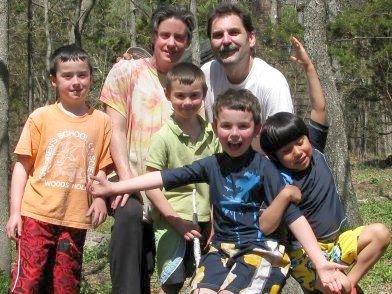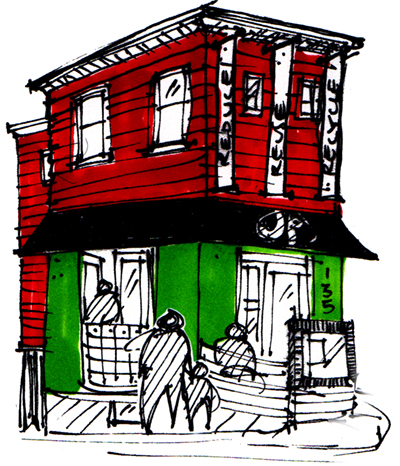Editor’s note: This month, Grist contributor Ken Ward and his partner Andrée Zaleska begin chronicling their conversion of a rundown, 100-year-old store into a green home that serves as both family living quarters and a public space for climate activism, green building education, and community gatherings. Recently, I visited the pair for a tour of the space — and an up-close glimpse of their dreams.
When the JP Green House is finished, it will be a marvel to behold. From the eco-insulation to the stage for community performances, from the backyard beekeeping to the front-stoop organizing, the house will be a glittering star in the firmament of eco-innovations.
But there’s a long way to go before that happens.
 A house of a different color.Courtesy Ken WardWhen I visited on a recent sunny day, the building — a 100-year-old former store in the Boston neighborhood of Jamaica Plain — was stripped to the studs. Invasive plants were creeping into an area reserved for raspberries and blackberries, and a benefit open house-yard sale over the weekend didn’t appear to have netted much more than a stolen wagon. (“No questions asked,” beseeched a small poster that had been hung out front.)
A house of a different color.Courtesy Ken WardWhen I visited on a recent sunny day, the building — a 100-year-old former store in the Boston neighborhood of Jamaica Plain — was stripped to the studs. Invasive plants were creeping into an area reserved for raspberries and blackberries, and a benefit open house-yard sale over the weekend didn’t appear to have netted much more than a stolen wagon. (“No questions asked,” beseeched a small poster that had been hung out front.)
It’s a long haul from here to eco-innovation, but Ken Ward and Andrée Zaleska are determined to make it work. Along with the three children who make up their combined family, they are creating a sustainable, zero-carbon home. They will live here, yes, and feast on food from their own gardens. But they will also open their doors to neighbors, to visitors curious about green building and sustainable living, and to climate activists committed to working toward a better future. It will be, they say, the first green-demo home in New England — and one of the very few in the country that is a retrofit, as opposed to new construction.
Ward, a frequent Grist contributor, is a veteran eco-activist who has served as deputy director of Greenpeace USA and co-founded Green Corps and U.S. PIRG. He’s also a high-energy carpenter, guitar player, and graphic designer. He might well be the dreamer in this undertaking, although the family’s JP Green House site describes him as its “true eco-curmudgeon.” With a bushy salt-and-pepper mustache and genial demeanor, he occasionally exudes a certain distracted-uncle air.
 Ward and Zaleska with their crew (l-r): Kuba and Simon Zalesky, Lucas Ward, cousin (and neighbor) Eli Ward Wikstrom.Courtesy Ken WardZaleska, by contrast, is intense, no-nonsense, quick to clarify or correct her partner’s proclamations as necessary. A longtime community organizer, she works on climate and economics issues with the Institute for Policy Studies and helps run the Jamaica Plain Forum, a local venue that hosts community conversations about planet-shaping issues. Writing on the family’s site, Zaleska makes no bones about why she and Ward have undertaken this work: “We feel that the times urgently demand a new model of family and community life.”
Ward and Zaleska with their crew (l-r): Kuba and Simon Zalesky, Lucas Ward, cousin (and neighbor) Eli Ward Wikstrom.Courtesy Ken WardZaleska, by contrast, is intense, no-nonsense, quick to clarify or correct her partner’s proclamations as necessary. A longtime community organizer, she works on climate and economics issues with the Institute for Policy Studies and helps run the Jamaica Plain Forum, a local venue that hosts community conversations about planet-shaping issues. Writing on the family’s site, Zaleska makes no bones about why she and Ward have undertaken this work: “We feel that the times urgently demand a new model of family and community life.”
And already, the community is responding to this new model. Neighbors have turned out for events like the open house, chipped in with green-building experiences and ideas, and offered support. Local newspaper and TV journalists have covered the story, and word of mouth is spreading. A local design firm has taken on the hard work of converting the building to passivhaus standards — an ultra-energy-efficient design that requires little or no heating or cooling — and other local tradespeople have come on board. That wagon even reappeared, courtesy of a neighbor who’d thought he was rescuing it from the trash.
So the buzz is building, and the JP Green House is beginning to take shape. Now the pressure’s on, Ward says; the family must take up residence by October, and the project is in a strange sort of funding limbo. The pair’s construction fund lost half its value over the past year, and they are, as one state official told them, “one year early” to take advantage of stimulus funding aimed at retrofits. Which means this summer will be a whirlwind of hammering, sawing, planting, weeding, dreaming — and strategizing.
Will Ward, Zaleska, and their crew be able to bring this building from bare studs to livable conditions in four months? What sacrifices will they have to make along the way? Can they find new sources of funding? And will the raspberries pull through?
Stay tuned as the JP Green House becomes a reality; meanwhile, see how the house looked when Ward and Zaleska started working on it, courtesy of the video tour below (and check ’em out on YouTube and Facebook, too!).

